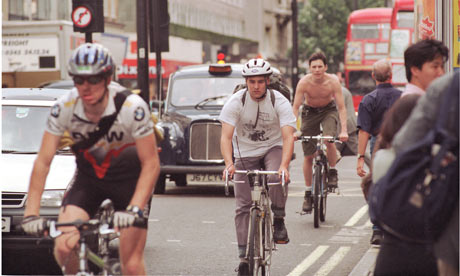
Cyclists' lobby group CTC said the report needed to focus on driver behaviour rather than issues such as cyclists wearing helmets. Photograph: Antonio Olmos
A tiny proportion of accidents involving cyclists are caused by riders jumping red lights or stop signs, or failing to wear high-visibility clothing and use lights, a government-commissioned study has discovered.
The findings appear to contradict a spate of recent reports speculating that risky behaviour by riders, such as listening to music players while cycling, could be behind a near 20% rise in cyclist deaths and serious injuries in the second quarter of this year.
The study, carried out for the Department for Transport, found that in 2% of cases where cyclists were seriously injured in collisions with other road users police said that the rider disobeying a stop sign or traffic light was a likely contributing factor. Wearing dark clothing at night was seen as a potential cause in about 2.5% of cases, and failure to use lights was mentioned 2% of the time.
The figures were slightly higher when the cyclist was killed, but in such cases only the driver's account is available.
The data, which was analysed by the Transport Research Laboratory (TRL), showed that more than a quarter of all cycling deaths in 2005-07 happened when a vehicle ran into the rear of a bike. This rose to more than one-third in rural areas and to 40% in collisions that took place away from junctions.
The 64-page analysis found that police attributed responsibility for collisions more or less evenly between drivers and cyclists overall, but this was skewed by the fact that when child riders were involved their behaviour was named as a primary factor more than three-quarters of the time.
With adult cyclists, police found the driver solely responsible in about 60%-75% of all cases, and riders solely at fault 17%-25% of the time.
The cyclists' lobby group CTC said the report showed that the government needed to focus more on driver behaviour rather than on issues such as cyclists wearing helmets. The TRL published a separate DfT-commissioned report today in which it was estimated that the universal use of helmets could save between 10 and 15 lives a year, a conclusion disputed by the CTC.
"The main cause of crashes seems to be 'failed to look properly', whereas very few cyclists are injured or killed acting illegally, such as failing to use lights at night or disobeying traffic signals," said Chris Peck, from the lobby group.
"We believe this report strongly supports our view that the biggest problem for cyclists is bad driving. With that in mind we are greatly concerned that the government still seems fascinated with analysing and promoting cycle helmets, the value of which appears to be inconclusive. We believe that the government should now focus on tackling the causes of injury which appears to be mainly inconsiderate and dangerous driving. Reduced speed limits, stronger traffic law enforcement and cycle-friendly road design are the solutions."
TRL recommended that more research be carried out into the relatively high numbers of young casualties, finding that those aged 10 to 15 were most at risk of injury for each mile cycled. Riders aged 16 to 29 were more likely to suffer harm than any other adult group.
The data – which covered incidents on the highways – showed that 3% of all collisions leading to deaths or serious injuries took place on bike lanes, and almost 80% of casualties happened during daylight hours. Just over 15% of all such accidents involved the cyclist alone.
From guardian.co.uk
